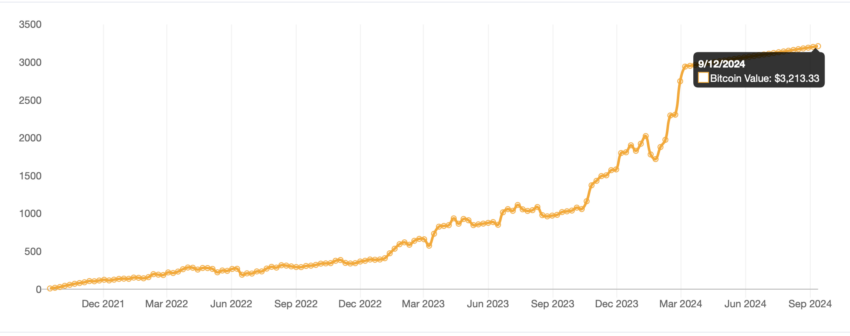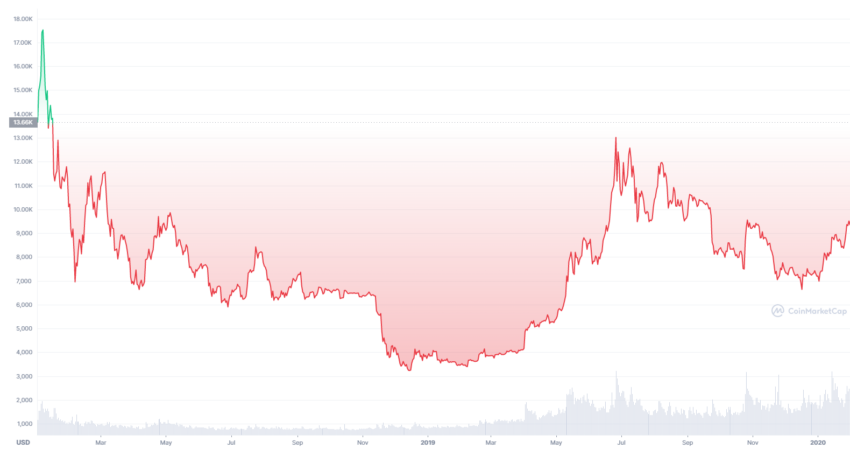As the saying goes, “even a fool can make money in a bull market.” The proof of your trading expertise as a trader lies in your performance in a bear market. Here are some proven methods to help you improve your investment strategies and survive a crypto bear market in 2024 and beyond.
KEY TAKEAWAYS
• Some strategies to help survive the crypto bear market include staying calm, not timing the bottom, dollar-cost averaging, and staking.
• You can also avoid shorting, assess the market, and remove your crypto from centralized exchanges.
• A bear market is a period of a prolonged drop in asset prices, in which the demand for assets is lower than the supply.
• Whether a bull or bear market, cycles do not last forever, typically between one and two years, so investors should keep this in mind when making decisions.
Top 7 ways to survive a crypto bear market

To survive a crypto bear market, you should:
- Stay calm and consider your options
- Don’t try to time the bottom
- Dollar-cost average
- Staking
- Avoid shorting
- Assess the market
- Take your crypto off exchanges
Let’s take a look at each of these strategies in a little more detail.
1. Stay calm and assess your options
Whether you see the bear market as an opportunity to buy the dip — or find falling crypto prices a bit too stressful to handle, always try to keep your cool and assess the situation objectively. Emotional decisions are the ones that you will most likely regret later on.
First, start by asking yourself why you are invested in crypto in the first place. Do you believe in crypto’s long-term success and want to tap into the many opportunities that it could bring along? Or are you just here to earn some quick bucks doing short-term trading?
The answer to this question could be your key to navigating the bear market unscathed.
2. Don’t try to time the bottom
Nobody — absolutely nobody — can accurately predict the bottom. Timing the bottom is a trading term that means trying to predict the end of a bear market. This is important when you make investments with the belief that the prices of your assets will increase. If you are wrong, the prices will decrease instead and could put you in a dire situation.
You may buy at what appears to be the bottom at a given time. However, the price could drop further. And if it does drop, you will have to sell it again to have your next shot at timing the elusive bottom. More often than not, this strategy will not allow you to make money in a bear market.
You can study technical and fundamental analyses and research expert opinion, but while this can inform your strategy, it won’t give you absolute confirmation of the bottom.
About 70-75% of traders lose and successful traders have a win/loss ratio around 50%. Accepting losing trades is a part of investing and trading, what matters is that your profitable trades and investments are more profitable than your losses.
3. Dollar-cost averaging (DCA)

Dollar-cost averaging, or DCA, is a simple but long-term strategy in which you continuously buy small amounts of an asset over a period of time, regardless of the price.
Dollar-cost averaging keeps you investing regardless of the market’s behaviour. And in a bear market, you will likely have the opportunity to buy assets at a lower price.
For example, a DCA schedule will have you investing, say, $10 in Bitcoin every week rather than investing $200 at once. You may make changes to your DCA schedule from time to time to meet your personal needs.

So, continuing from the example above, suppose you started buying $10 worth of Bitcoin every week starting in 2021. Now, using a DCA calculator, you will find that, by now, you would have $3,213 (as of mid-September 2024).
4. Consider staking
When the going gets tough in a crypto bear market, staking can be a good way to earn passive income and enhance your portfolio management strategy.
Staking is the practice of locking away your coins on a proof-of-stake (PoS) blockchain for a period of time and earning rewards for doing so. Because your fund is securely locked on a blockchain, staking also lowers the possibility of panic selling.
Note that staking does not guarantee profits. If an asset’s price dives significantly, you can still lose money.
5. Avoid shorting in a crypto bear market

Shorting is a technique traders use to profit from falling crypto prices. It should ideally be an excellent fit in a bear market when price drops are common.
However, most experts advise against shorting Bitcoin and other cryptocurrencies because it could potentially lead to unlimited losses or liquidation of your position. This is a fundamental problem with shorting, and no amount of experience can prepare you for the rude shocks when things go bad.
When you buy a crypto (go long), you can never really lose more than the amount you have invested. For example, say you have purchased BTC worth $100. So, the maximum you could lose from that crypto investment is $100.
On the other hand, the potential gain, at least on paper, could be limitless. Think of a scenario where the BTC price increases so much that the $100 investment returns $500, $1,000, $10,000…..and so on.
It’s just the opposite with shorting. If you short a coin at $100, the maximum you will earn from that trade is $100. However, if the price of the crypto starts increasing and the uptrend continues, your losses could pile up indefinitely.
And if you short using margin, you will have to keep paying the interest charges on top of the original loss for as long as you choose to keep the position open.
6. Carefully assess the current state of the market

As of mid-2024, in the middle of the current bullish trend, Bitcoin seems to have found major support near $60,000. In light of the U.S. Bitcoin spot ETF approvals and interest rate pauses by the U.S. Federal Reserve, many investors have anticipated an impending bull market and all-time highs (ATH).
As a result, Bitcoin reached an all-time high of over $73,000 in March 2024. Despite this fact, major altcoins have yet to reach all-time highs, which typically happens in crypto bull markets but has not happened in the 2024 bull cycle.
The point here is that it is important to stay updated and have situational awareness about the current state of the market. This way, you stand the best chance to position yourself accordingly, act quickly, and minimize losses.
7. Avoid leaving your crypto on exchanges

Like they say, “not your keys, not your coins.” This is applicable in pretty much any scenario involving a centralized, custodial crypto exchange. However, the risks of irretrievably losing your funds stored in these exchanges become even bigger during a turbulent bear market.
Consider what might happen if there was a sudden market crash? Billions of dollars would be wiped out from the market, causing many exchanges to end up insolvent.
Always opt for a non-custodial wallet app or, better still, a tried-and-tested hardware wallet, like Trezor or Safepal, to have full control over your crypto stash. Following these tips will teach you how to survive crypto bear markets.
What is a bear market?

For those out of the loop, a bear market can be best defined as a prolonged drop in asset prices, which then causes your portfolio to shed value.
In a bear market, the supply of an asset is typically higher than the demand because a large chunk of investors (known as “bears”) start offloading (selling) loss-making assets from their portfolios, fearing further price drops.
Bull vs. bear market
| Bear market | Bull market |
|---|---|
| A prolonged fall in asset prices (usually a 20% decline in overall market index) | Asset prices rise over a prolonged period of time |
| Demand for assets are typically higher than the supply | Demand for assets is typically higher than the supply |
| Characterized by selling assets | Characterized by buying assets |
| More difficult to invest | Typically easier to invest |
| Significant business failures | Significant froth and speculation |
A bull market is diametrically opposite to a bear market. A bull market is when the price of an asset or asset class is on the rise over a prolonged period, which then results in a spike in your portfolio valuation.
Bull markets start when investors feel confident that prices will increase and the uptrend will continue over a prolonged period. In anticipation, they start buying and holding the assets that they believe will benefit the most from the bull market.
In other words, a lot of investors are willing to buy during a bull market while few are willing to sell. Thus, the demand becomes higher than the supply and the price starts increasing. This way, investors’ predictions about bullish market conditions turn into a self-fulfilling prophecy.
In contrast, bear markets begin when investors are low on confidence and start believing that prices will continue falling. A few facts to note here to better highlight the bull vs bear market dynamics:
- While some investors can be bearish, the vast majority of investors are generally fundamentally bullish. Most asset classes including digital assets typically post positive returns on investments (ROI) in the long run.
- Bear markets are usually short-lived compared to bull markets.
- Between the two, a bear market is more difficult to invest in and navigate because many assets rapidly shed value, and prices tend to become much more volatile.
- Investors’ psychology and risk aversion play a big role in determining whether a market is bullish or bearish. However, that’s not the only factor. Supply and demand, socioeconomic stability, as well as activities in the broader financial markets also play a key role in making the market sway one way or the other.
What is crypto winter?
The most dreaded season in crypto’s short history so far, “crypto winter,” refers to a prolonged bearish period during which prices of most digital assets continue to dip over several months.
The price drop in a crypto winter tends to be very steep. For example, during the crypto winter that took place between early 2018 and mid-2020 (although estimates vary), Bitcoin shed almost 88% of its value as compared to its then all-time high price.
The broader cryptocurrency market also felt the icy chill of the last crypto winter. In fact, many popular coins saw up to 90–95% price drops (compared to their ATHs). This period led to significant losses. That is why it is paramount for retail and institutional investors to know how to survive crypto bear markets.
Best strategies to overcome a Bitcoin bear market

As the most popular coin (by market cap), Bitcoin is a trendsetter in the crypto market. So, if a crypto bear market is looming on the horizon, the first signs of it are almost always visible in Bitcoin’s price movement. Other cryptocurrencies just rally behind it — so far, at least. This observation holds even during subsequent cycles when the market recovers and eventually starts a new bull run.
Diversify your portfolio
However, based on the data from previous bear markets, it is safe to say that Bitcoin always bounces back. So, the vast majority of experts and industry insiders are of the view that the best way to survive a Bitcoin bear market is to hodl and patiently wait out the storm.
Secondly, holding Bitcoin is a good strategy for long-term investment, but an important part of risk management is to diversify investments. This could mean owning crypto investments in addition to stocks, bonds, commodities, etc.
Diversification can also mean holding cash. Financial planning involves hedging against market volatility. Fiat currency (USD in particular) is often a preferred asset of hedging against market volatility. You can hold stablecoins or cash in this scenario.
Having a long-term outlook is essential as opposed to giving in to the urge to panic selling. Furthermore, try to avoid trading when the market is in a bearish phase — especially if you have little to no prior exposure to trading.
Whether it is a bull or bear market, markets do not last forever, as stated by CNBC Finance Editor Jeff Cox.
Contrary to popular belief, bull markets do not last forever. Now we have seen in the past, when markets do reach that 20% decline, what usually follows is a total 30 % decline. And it can take up to two years on average for markets to get back to their original values…
Jeff Cox, CNBC Finance Editor
Crypto winters are not the end
Have no doubt that as an investor or a trader, you’re bound to lose money occasionally. A 100% success rate is practically impossible, no matter how seasoned you are in the game. However, by following the bear market strategies discussed above, you will significantly reduce your chances of falling prey to crypto bears.
Alongside, make sure to stick to the other basics such as always using stop-losses in case you are trading. These tips can help sharpen your mental resilience while teaching you how to survive crypto bear markets.
Frequently asked questions
How long does a bear market last?
Is crypto winter real?
How long does a crypto winter last?
What are bear and bull markets?
Is crypto in a bear market?
What does a bear mean in crypto?
Should you hold crypto through a bear market?
Disclaimer
In line with the Trust Project guidelines, the educational content on this website is offered in good faith and for general information purposes only. BeInCrypto prioritizes providing high-quality information, taking the time to research and create informative content for readers. While partners may reward the company with commissions for placements in articles, these commissions do not influence the unbiased, honest, and helpful content creation process. Any action taken by the reader based on this information is strictly at their own risk. Please note that our Terms and Conditions, Privacy Policy, and Disclaimers have been updated.




